BPAC, Cycle Tracks & Bike Racks; oh my!
North Central Texas Council of Government’s Bicycle and Pedestrian Advisory Committee (BPAC) held its first meeting of the year this past Wednesday. You may be wondering what NCTCOG and BPAC are, and what they have to do with Knox-Henderson, or any sorta bike friendliness.
NCTCOG is an organization of governments in the metroplex (known to planners as an MPO or metropolitan planning organization). This voluntary association helps municipalities make joint decisions and address regional concerns. NCTCOG deals with issues ranging from transportation to the environment, emergency preparedness to workforce development. We are obviously interested in bicycle related issues and that is where the Bicycle and Pedestrian Advisory Committee comes in. BPAC is a committee made up of representatives from COG’s member cities. The goals of BPAC are to provide technical assistance, education & training, review of bicycle and ped plans, and to give recommendations to the Regional Transportation Council. BPAC also creates a “Report Card” for member cities based on whether or not they regularly participate and attend.
Back to how BPAC relates to us here at Knox-Henderson… BPAC typically showcases examples of bicycle infrastructure (like signage, safety treatments, cycle tracks, bike parking for example) throughout the metroplex, the country, and the world. At the most recent meeting, we saw presentations on cycle tracks. Cycle tracks are physically separated bicycle paths which we think is a great option for creating a more bicycle friendly environment on Knox-Henderson. BPAC also gets these types of projects on the radar and in the minds of local planners and decision makers, which is an important step.

Photo of cycle track on redesigned Vassar Street in Cambridge, Mass
For an overview of the meeting and more on cycle tracks, you can read on…
Prior to the meeting, attendees participated in a webinar on Design Practices for Cycle Tracks. Presenters included: Peter Furth (Professor of Civil Engineering at Northeastern University), Cara Seiderman (Transportation Program Manager for City of Cambridge, Mass), Rob Burchfield (City Traffic Engineer for Portland Bureau of Transportation), and Hayes Lord (Director of the Bicycle Program for NYC Department of Transportation). The presentations gave plenty of examples of successful implementation of bike infrastructure in the US and abroad with an emphasis on separated bike lanes, or cycle tracks. Some highlights of the presentations:
- Peter Furth addressed general design treatments and safety statistics associated with cycle tracks and mentioned what he called “The Myth of the Danger of Separated Paths,” dismissing the claim that separated paths have a greater crash risk. He pointed out a study he has been conducting in Montreal over the last ten years indicating that the crash risk in cycle tracks is 28% smaller than the in-street risk.
- Seiderman identified the following reasons for choosing to implement cycle tracks: improving safety, eliminating shared lane conflicts, increasing comfort on high speed/high volume roadways, attracting new riders, supporting economic development, enhancing pedestrian environment, supporting environmental goals. She emphasized that cycle tracks consider all design users. She then showcased the streetscape redesign of Vassar Street at MIT in Cambridge, Mass which included two one way cycle tracks (pictured above)
- Robert Burchfield gave an overview of a cycle track project on the Portland State University campus that converted a one way three lane street to a street with two travel lanes, on-street parking, and a 7’ wide bike lane with a 3’ buffer zone between parking stalls and cycle track. Burchfield addressed the design treatments that were used and some of the challenges the project dealt with. You can find a brochure and more information about the project here: Portland Loves Cycling
- Hayes Lord gave some impressive stats about the NYC experience with cycle tracks: in the last 3 years, the NYC has doubled its number of commuter cyclists (from 8,650 in 2006 to 15,495 in 2009) by adding over 200 miles of bike lanes. NYC uses a number of different types of bike lanes including signal protected paths, 2-way protected paths, separated paths with mixing zones, and cycles tracks. Lord gave an overview of how these treatments were implemented in the examples of 9th Avenue, Grand Street, and Kent Street alone with safety stats and comparative cost estimates.
You can view the slides for all of these presentations here: Cycle Tracks Presentation
At the conclusion of the webinar, the BPAC meeting got underway with an announcement of the 2010 BPAC Chair (Renee Burke Jordan, City of Plano) and Vice Chair (David Boski, City of Mansfield). The chair discussed the intended role of the BPAC for 2010 which is to provide a forum for attendees (usually bike/ped professionals, members from advocacy groups, etc) to network; provide education through webinars & seminars; and to provide input to the Regional Transportation Council. Burke Jordan also mentioned some potential future agenda items for the BPAC which included a discussion on creating a Complete Streets Model Ordinance for COG. I know some local city planners that would find that very useful!!
Next, representatives from DART, DCTA, and The T gave presentations on how their respective transit authorities are working to interface with cyclists and enhance bicycle access to transit. The good news here is that all of these transit providers are making available bike racks on busses, bike hooks on trains, and short and long term bike storage and parking options at transit centers, allowing commuters to extend their trips. For more specifics you can check out their presentations:
- Rafael Sustaita for DART on the Bike & Ride Program
- Boris Palchik for DCTA on their bike initiatives
- Carl Weckenmann for The T on their bike ped programs
NCTCOG Transportation Planner Deborah Humphreys gave an update on the 2009-2010 Statewide Transportation Enhancement Program (STEP). COG received 59 project applications for the federal funding. Staff ranked the projects based on 9 indicators and submitted rankings to Austin.
Humphreys also discussed Mobility 2035, a new long range transportation plan in the works that is in need of your input! Take the survey here
Finally, Vice Chair Boski made some announcements about upcoming training opportunities and future events and wrapped up the show.
FYI, the next BPAC meeting is scheduled for May 19. These meetings are open to the public, and really informative for anyone interested in bike/ped planning in the region.
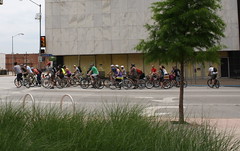



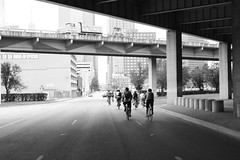

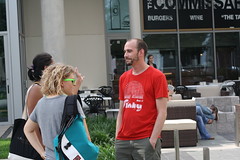
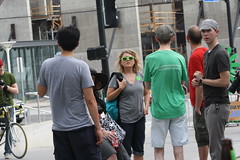

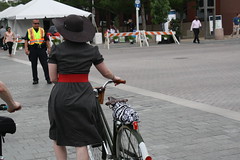
Comments
One Response to “BPAC, Cycle Tracks & Bike Racks; oh my!”Trackbacks
Check out what others are saying...[…] BPAC, Cycle Tracks & Bike Racks; oh my! by bike friendly knox-henderson North Central Texas Council of Government’s Bicycle and Pedestrian Advisory Committee (BPAC) held its first meeting of the year this past Wednesday. You may be wondering what NCTCOG and BPAC are, and what they have to do with Knox-Henderson, or any sorta bike friendliness. […]